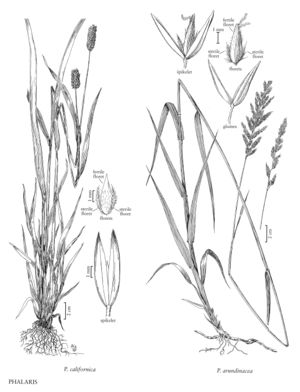Difference between revisions of "Phalaris californica"
FNA>Volume Importer |
FNA>Volume Importer |
||
| Line 17: | Line 17: | ||
-->{{Treatment/Body | -->{{Treatment/Body | ||
|distribution=Calif.;Oreg. | |distribution=Calif.;Oreg. | ||
| − | |discussion=<p | + | |discussion=<p>Phalaris californica is native to California and southwestern Oregon. It grows in ravines and on open, moist ground. Records from further north probably represent introductions. The relatively long, sterile florets of P. californica distinguish it from other species of Phalaris in the Flora region.</p> |
|tables= | |tables= | ||
|references= | |references= | ||
| Line 33: | Line 33: | ||
|basionyms= | |basionyms= | ||
|family=Poaceae | |family=Poaceae | ||
| + | |illustrator=Linda A. Vorobik and Hana Pazdírková | ||
|distribution=Calif.;Oreg. | |distribution=Calif.;Oreg. | ||
|reference=None | |reference=None | ||
| Line 38: | Line 39: | ||
|publication year= | |publication year= | ||
|special status= | |special status= | ||
| − | |source xml=https:// | + | |source xml=https://bibilujan@bitbucket.org/aafc-mbb/fna-data-curation.git/src/314eb390f968962f596ae85f506b4b3db8683b1b/coarse_grained_fna_xml/V24/V24_1092.xml |
|subfamily=Poaceae subfam. Pooideae | |subfamily=Poaceae subfam. Pooideae | ||
|tribe=Poaceae tribe Poeae | |tribe=Poaceae tribe Poeae | ||
Revision as of 17:05, 30 October 2019
Plants perennial; cespitose, not rhizomatous. Culms 60-160 cm, swollen at the base. Ligules 3-5(8) mm, truncate to acute, irregularly erose; blades 5-35 (40) cm long, 3-12(18) mm wide, smooth. Panicles 1.5-6 cm long, 1-3 cm wide, ovoid to cylindrical, often purplish, often truncate at the base; branches not evident, spikelets borne singly, not clustered. Spikelets homogamous, with 3 florets, terminal floret bisexual; disarticulation above the glumes, beneath the sterile florets. Glumes 5-8 mm long, 0.9-1.6 mm wide, acute to acuminate, keels not or only narrowly winged distally, wings to 0.2 mm wide, scabrous, lateral veins conspicuous, smooth; sterile florets 2, equal or subequal, 1.8-3.5 mm, usually more than 1/2 as long as the bisexual florets, densely hairy; bisexual florets 3.5-5 mm long, 1-1.5 mm wide, sparsely hairy, shiny, stramineous, becoming darker at maturity, apices acute to weakly acuminate; anthers 3-3.5 mm. 2n = 28.
Discussion
Phalaris californica is native to California and southwestern Oregon. It grows in ravines and on open, moist ground. Records from further north probably represent introductions. The relatively long, sterile florets of P. californica distinguish it from other species of Phalaris in the Flora region.
Selected References
None.
